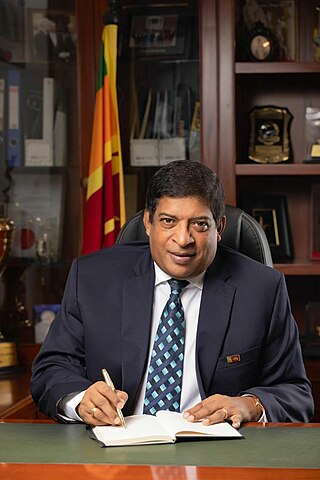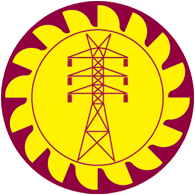
Ravindra Sandresh Karunanayake is a Sri Lankan politician. A former Member of Parliament for the Colombo District, he served as the Minister of Foreign Affairs from May 2017 to August 2017, Minister of Finance from 2015 to 2017, and Cabinet Minister of Commerce and Consumer Affairs from 2001 to 2004 and Cabinet Minister of Power and Energy since December 2018 till November 2019.

The Ceylon Electricity Board - CEB, is the largest electricity company in Sri Lanka. With a market share of nearly 100%, it controls all major functions of electricity generation, transmission, distribution and retailing in Sri Lanka. It is one of the only two on-grid electricity companies in the country; the other being Lanka Electricity Company (LECO). The company earned approximately Rs 204.7 billion in 2014, with a total of nearly 5.42 million consumer accounts. It is a government-owned and controlled utility of Sri Lanka that takes care of the general energy facilities of the island. The Ministry of Power and Energy is the responsible ministry above the CEB. Ceylon Electricity Board (CEB), established by the CEB Act No. 17 of 1969, is under the legal obligation to develop and maintain an efficient, coordinated and economical system of electricity supply in accordance with any licenses issued.

The Lakvijaya Power Station is the largest power station in Sri Lanka.

The electricity sector in Sri Lanka has a national grid which is primarily powered by hydroelectric power and thermal power, with sources such as photovoltaics and wind power in early stages of deployment. Although potential sites are being identified, other power sources such as geothermal, nuclear, solar thermal and wave power are not used in the power generation process for the national grid.

Ceylon Petroleum Corporation, commonly known as CEYPETCO (CPC), is a Sri Lankan oil and gas company. Established in 1962 and wholly owned by the Government of Sri Lanka, it is the largest oil company in Sri Lanka. It was formed in 1961 by nationalisation and expropriation of all private oil companies in Sri Lanka at the time of its formation. It is under the ownership of Ministry of Petroleum Resources Development headquartered in Colombo. It is the largest government owned company in the country, with an operational profit of Rs. 33.9 billion for the financial year 2020.
The Kelanitissa Power Station is a state-owned power station located on the south bank of the Kelani River in the northern part of the city of Colombo, Sri Lanka. Commissioned in 1964, it is the first thermal power station built in Sri Lanka, after the country gained independence. The facility has a current gross installed capacity of 360 MW, a significant amount when compared to the total installed capacity of nearly 4,086 MW in the year 2017. The facility is owned and operated by the Ceylon Electricity Board.
The Aggreko Power Station (2003-2012) was a temporary 20-megawatt fuel oil-fired power station in Sri Lanka. It was commissioned in October 2003 after power generation company Aggreko won an open bid offered by the Ceylon Electricity Board to overcome the Sri Lanka energy crisis faced in the 1990s to early 2000s. It was decommissioned on 31 December 2012. Prior to decommissioning, Aggreko sold electricity to the Ceylon Electricity Board at a rate of Rs. 26 per KWh.
Chunnakam Power Station was a thermal power station in Chunnakam in northern Sri Lanka. Commissioned in 1958, the station is owned and operated by the state-owned Ceylon Electricity Board (CEB). It was decommissioned in 2013, and replaced by the Uthuru Janani Power Station, which is constructed less than 100m south of the Chunnakam Power Station.

The Thambapavani Wind Farm named after Thambapanni and Pavan meaning wing in Sinhalese. Also called Mannar Island Wind Farm or Mannar Wind Farm) is a 100-megawatt wind farm which was built on the southern coast of the Mannar Island, in Sri Lanka. The project would cost approximately US$200 million, 78% of which will be borne by the Asian Development Bank, while the remaining 22% will be borne by the developers, the Ceylon Electricity Board. Identification of land plots and ownership has already begun. It is currently regarded as the largest wind farm in Sri Lanka and it is also the first wind power plant to be owned by the Ceylon Electricity Board.

The Public Utilities Commission of Sri Lanka is the government entity responsible for policy formulation and regulation of the electric power distribution, water supply, petroleum resources, and other public utilities in Sri Lanka.

Parliamentary elections were held in Sri Lanka on 5 August 2020 to elect 225 members to Sri Lanka's 16th Parliament. 16,263,885 people were eligible to vote in the election, 31.95% of whom were young voters.
This page lists notable events that took place in the year 2019 in Sri Lanka. The year 2019 had the fewest non-working holidays in the country as most of the public holidays fell on weekends.

Presidential elections were held in Sri Lanka on 16 November 2019. The incumbent President Maithripala Sirisena's term of office would have ended on 9 January 2020. This was the first presidential election in Sri Lanka where no sitting president, prime minister or opposition leader ran for president. Gotabaya Rajapaksa won the election in a landslide victory, defeating his main opponent Sajith Premadasa.

The Sojitz Kelanitissa Power Station, is privately owned 172 MW diesel-fired combined cycle power station located in Kelanitissa, in the city of Colombo, Sri Lanka. It is owned by Sojitz Kelanitissa Private Limited, a subsidiary of Sojitz Corporation. The power station is located adjacent to the Kelanitissa Power Station, which is a separate government-owned power station.
The COVID-19 pandemic in Sri Lanka is part of the ongoing worldwide pandemic of coronavirus disease 2019 (COVID-19) caused by the severe acute respiratory syndrome coronavirus 2 virus. The first case of the virus in Sri Lanka was confirmed on 27 January 2020, after a 44-year-old Chinese woman from Hubei, China, was admitted to the Infectious Disease Hospital in Angoda, Sri Lanka. As of 15 December 2022, a total of 671,776 COVID-19 cases had been recorded in the country, 654,919 patients had recovered from the disease, and 16,814 patients had died.

Mohamed Uvais Mohamed Ali Sabry, PC, MP, also known as Ali Sabry, is a Sri Lankan lawyer and politician. He is the Current Minister of Foreign Affairs serving since 22 July 2022. He previously served as the Minister of Finance until 9 May 2022. He was a Member of Parliament, appointed from the national list of the Sri Lanka Podujana Peramuna. He also served as the Minister of Justice until 9 May 2022. He served as the defense counsel of President Gotabaya Rajapaksa, chief legal adviser and President of the Muslim Federation of the Sri Lanka Podujana Peramuna.
The 2020 Sri Lankan blackouts were a series of electrical blackouts that occurred on 17 August 2020, beginning around 12.30 pm SLST (UTC+5:30) and lasting over seven hours. The nationwide blackouts occurred due to a transmission technical failure at the Kerawalapitiya Grid-Sub station. The Ceylon Electricity Board announced that the cause of the blackout had not yet been determined, describing it as an unspecified failure. The Ministry of Power stated that a special committee had been appointed to investigate the root cause behind the blackout.

The Sri Lankan economic crisis is an ongoing crisis in Sri Lanka that started in 2019. It is the country's worst economic crisis since its independence in 1948. It has led to unprecedented levels of inflation, near-depletion of foreign exchange reserves, shortages of medical supplies, and an increase in prices of basic commodities. The crisis is said to have begun due to multiple compounding factors like tax cuts, money creation, a nationwide policy to shift to organic or biological farming, the 2019 Sri Lanka Easter bombings, and the impact of the COVID-19 pandemic in Sri Lanka. The subsequent economic hardships resulted in the 2022 Sri Lankan protests. Sri Lanka received a lifeline in the form of an Indian line of credit amounting to $4 billion. This substantial credit infusion served to cover the costs of importing essential goods and fuel. As a result, the foreign currency reserves of debt-ridden Sri Lanka experienced a notable improvement, reaching $2.69 billion.

The 2022 Sri Lankan protests, commonly known as Aragalaya, were a series of mass protests that began in March 2022 against the government of Sri Lanka. The government was heavily criticized for mismanaging the Sri Lankan economy, which led to a subsequent economic crisis involving severe inflation, daily blackouts, and a shortage of fuel, domestic gas, and other essential goods. The protesters' main demand was the resignation of President Gotabaya Rajapaksa and key officials from the Rajapaksa family. Despite the involvement of several opposition parties, most protesters considered themselves to be apolitical, with many expressing discontent with the parliamentary opposition. Protesters chanted slogans such as "Go Home Gota", "Go Home Rajapaksas", and "Aragalayata Jaya Wewa". Most protests were organized by the general public, with youths playing a major part by carrying out protests at Galle Face Green.












